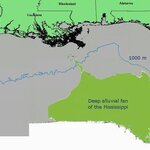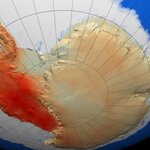Oceanography

Right now we have a tandem situation. Jason-1 and Jason-2 are flying in tandem above our heads. Sounds like fun perhaps, but who cares? And who are Jason and what's with the numbers, anyways?
Credit: NASAA "family portrait" of Jason-1, Topex/Poseidon, and Jason-2 for 28-Jan-09 at 23:39 UTC,showing the position of all three satellites as they descend to the southeast, passing over ground station just outside of Toulouse, France.
Obviously we are talking about two distinct Jason's; Jason-1 and Jason-2. They are both satellites orbiting planet Earth carrying altimetry instruments. An altimeter…

Google Earth has the answer to this question, apparently. Developers are starting to include ocean floor data in the maps accessible via the program. It's about time, really- but first I have to vent a bit...
I often wonder what is so fascinating about Google Earth that makes my fiancee able to sit, staring at the computer, and zoom around from various angles looking at the same map for hours on end. Don't get me wrong, I think Google Earth is cool, and I do use it in some of my lessons in the classroom. But it doesn't thrill me the way that, say, my RSS…

Charles Darwin wrote in 1835 about the Galapagos Islands:
"September 15th — This archipelago consists of ten principal islands, of which five exceed the others in size. They are situated under the Equator, and between five and six hundred miles westward of the coast of America. They are all formed of volcanic rocks; a few fragments of granite curiously glazed and altered by the heat can hardly be considered as an exception.
Some of the craters surmounting the larger islands are of immense size, and they rise to a height of between three and four thousand feet. Their flanks are…

Are you ready for a treat? Have you ever wished you could be with Charles Darwin on his travels just for one day? Perhaps -- when he first saw immense glaciers? Well, I've arranged today to imagine what-and-where of him and the Beagle in South America. Charles Darwin enjoyed 29 January 1833 because his notes are joyful and eventful. See for yourself."In many parts, magnificent glaciers extend from the mountain side to the water's edge. It is scarcely possible to imagine anything more beautiful than the beryl-like blue of these glaciers, and especially…

Dumping tires in the water to create an artificial reef sounds either inspired or crazy. It turned out to be crazy but there was a scientific hypothesis to it. You just had to buy into their chain of logic.
There was also a lesson. Not everything needs to be done in a large experimental setting but the justification to go ahead and do it is always cost and the protecting the environment right now. 'You care about the environment, right?' I can't think of a single time a question has been phrased that way that someone hasn't tried to sell me something. …

Dead zones are low-oxygen areas in the ocean where higher life forms such as fish, crabs and clams are not able to live. In shallow coastal regions, for examples, dead zones can be caused by runoff of excess fertilizers from farming.
A team of Danish researchers is projecting that unchecked global warming would lead to a dramatic expansion of low-oxygen areas zones in the global ocean by a factor of 10 or more.
Whereas some coastal dead zones could be recovered by simply controlling fertilizer usage, expanded low-oxygen areas caused by global warming might remain for many years. The…

The consensus among scientists has been that while much of the globe has been getting warmer, a large part of Antarctica – the East Antarctic Ice Sheet – has actually been getting colder. Not so, say Eric Steig, a University of Washington professor of Earth and space sciences, and colleagues in Nature.
They contend that for the last 50 years much of Antarctica has been warming at a rate comparable to the rest of the world and the warming in West Antarctica is greater than the cooling in East Antarctica, meaning that on average the continent has gotten warmer. The West Antarctic…

Michael Shermer of Michael Shermer: What Will ET Look Like? has inspired me to write a sci fi. Shermer's ET, whether a bipedal primate or not, is attractive for a theme of oceans and humans -- both representing new experiences. An extraterrestrial, you might agree, is also ideal to ask questions to our hero, as suggested by me, to be played by Michael Shermer.
Each of us seems to be that child on the beach gazing at the waves rushing in -- followed by a fast race back to safety -- wearing sea foam froth on our wet feet.…

With record low temperatures, winter blizzards and warming that isn't really global, people aren't taking climate change very seriously these days, but that doesn't mean pollution gets a free pass if we want to continue to enjoy nature as we know it. Temperature change in the Arctic can still happen regardless of what is happening in cold spots of the world and it may be happening at a greater rate there than other places in the Northern Hemisphere.
As a result, glacier and ice-sheet melting, sea-ice retreat, coastal erosion and sea level rise could continue even if it doesn't…

In the good old days, when I lived in Florida, if you had a completely ridiculous idea but convinced someone else who had some authority, you could get it implemented. There being no Internet, it didn't have to be a great idea, if it went bad you could just make it go away.
But in the Internet Age, every dumb thing you do is permanent, so we can laugh at the idea of using 2 million tires to make an artificial coral reef today but in the Florida of my youth, this made complete sense to environmentalists - and they found data to back it up. The clean-up would be left…